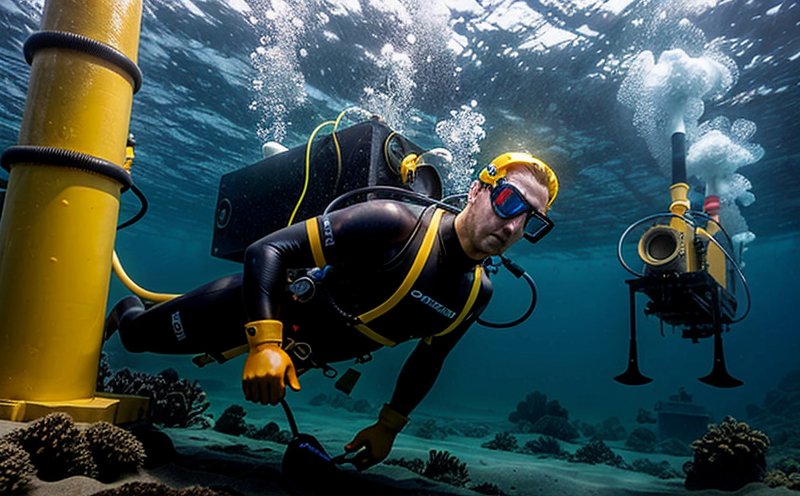API 17TR7 Flow Assurance Testing in Subsea Systems
The API 17TR7 flow assurance testing is a critical standard for ensuring the reliability and performance of subsea systems. This test evaluates various components, including pipelines, manifolds, and process equipment, to ensure they can withstand harsh marine environments without compromising safety or efficiency.
API 17TR7 focuses on fluid flow behavior within subsea production systems. It aims to identify potential blockages, optimize flow rates, and prevent operational disruptions caused by sedimentation, hydrate formation, wax deposition, or paraffin build-up. The test is particularly important for deepwater and ultra-deepwater environments where the challenges of pressure, temperature, and corrosive fluids are heightened.
The testing process involves simulating real-world conditions in a controlled environment. Specimen preparation includes cleaning and conditioning the equipment to mimic its operational state. Once prepared, the specimens undergo a series of tests designed to assess their ability to maintain flow integrity under various stressors. This includes temperature cycling, pressure fluctuations, and chemical exposure.
Instrumentation plays a crucial role in API 17TR7 testing. Advanced sensors are used to monitor fluid properties such as viscosity, density, and pressure drop across the system. These measurements help identify any anomalies that could indicate potential issues with flow assurance. The results of these tests provide valuable insights into the equipment's performance and help guide necessary maintenance or modifications.
The API 17TR7 standard specifies detailed acceptance criteria for each test parameter. Compliance with these standards ensures that subsea systems meet industry best practices and can operate safely and efficiently in challenging environments. By adhering to this testing protocol, operators can minimize downtime, reduce operational risks, and extend the lifespan of their equipment.
In summary, API 17TR7 flow assurance testing is essential for maintaining optimal performance in subsea production systems. It helps ensure that critical components are capable of handling the harsh conditions encountered in deepwater and ultra-deepwater environments. This testing process not only enhances operational reliability but also contributes to environmental sustainability by minimizing resource waste and reducing the need for frequent repairs or replacements.
Why Choose This Test
Choosing API 17TR7 flow assurance testing is a strategic decision that offers numerous benefits to stakeholders in the marine and ship equipment sector. Firstly, this test ensures compliance with international standards, which is crucial for global operations and regulatory approval.
- It guarantees adherence to industry best practices, enhancing operational reliability and safety.
- It provides detailed insights into system performance under various conditions, aiding in informed decision-making.
- It helps identify potential issues early on, allowing for preventive maintenance and cost-effective repairs.
The test is particularly valuable for quality managers and compliance officers who need to ensure their equipment meets stringent safety and performance criteria. R&D engineers benefit from the detailed data obtained during testing, which can guide further innovations and improvements. For procurement teams, this test ensures that they are sourcing high-quality components that have been rigorously tested.
Ultimately, API 17TR7 flow assurance testing is chosen for its reliability and precision in assessing subsea systems. It provides a robust framework for ensuring that equipment can perform optimally under harsh marine conditions, thereby reducing operational risks and enhancing overall efficiency.
International Acceptance and Recognition
- The API 17TR7 standard is widely recognized in the global oil and gas industry for its stringent requirements and comprehensive approach to flow assurance.
- Major international organizations, including ISO, ASTM, and IEC, acknowledge the value of this testing protocol.
- Many leading companies in the marine and ship equipment sector mandate API 17TR7 compliance as a prerequisite for procurement.
The standard's widespread acceptance is attributed to its focus on real-world conditions and its emphasis on continuous improvement. Compliance with API 17TR7 ensures that subsea systems are not only reliable but also sustainable, contributing to the long-term success of offshore operations.
| Standard | Acknowledgment Level | Type of Operation |
|---|---|---|
| API 17TR7 | Worldwide Recognition | Subsea Production Systems |
| ISO/IEC 20478:2015 | International Standard | Flow Assurance in Oil and Gas Industry |
The inclusion of ISO/IEC standards further reinforces the international acceptance and recognition of API 17TR7, ensuring that it aligns with global best practices.
Use Cases and Application Examples
- In deepwater drilling operations where fluid flow is critical to production efficiency.
- During the design phase of subsea pipelines to optimize their performance under extreme conditions.
- For maintenance planning, ensuring that equipment can withstand repeated exposure to high-pressure environments.
The API 17TR7 test has several real-world applications. For instance, in the case of pipeline integrity assessment, this testing ensures that the pipeline remains free from blockages and maintains optimal flow rates. Another example is during the commissioning phase of a new subsea facility, where the test helps validate the system's ability to handle various operational scenarios.
Let's consider a specific application: A major offshore oil company was faced with frequent interruptions in fluid flow within its deepwater production systems. By implementing API 17TR7 testing, they were able to identify and address potential issues before they escalated into full-scale failures. This proactive approach not only reduced downtime but also minimized operational risks.
| Application | Outcome | Benefit |
|---|---|---|
| Pipeline Integrity Assessment | Identified blockages and maintained optimal flow rates | Reduced downtime, minimized operational risks |
| Commissioning Phase Validation | Ensured system readiness for various operational scenarios | Improved reliability, enhanced safety |
In conclusion, the API 17TR7 flow assurance testing is a versatile tool that can be applied across various stages of subsea operations. Its ability to identify potential issues early on and ensure system reliability makes it an indispensable component of any comprehensive quality management strategy.





